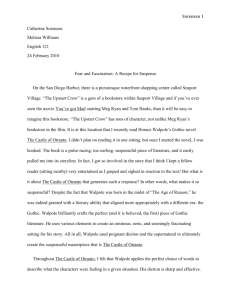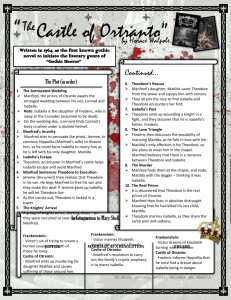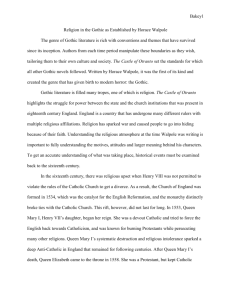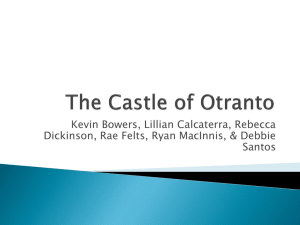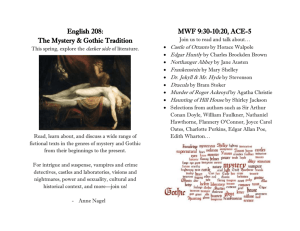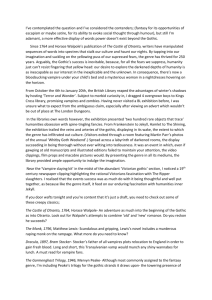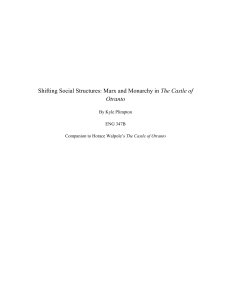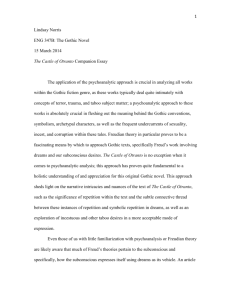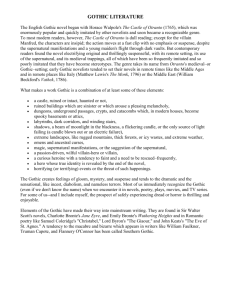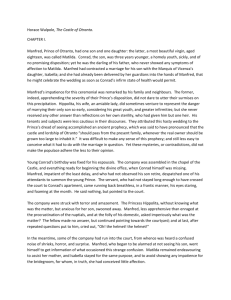The Castle of Otranto
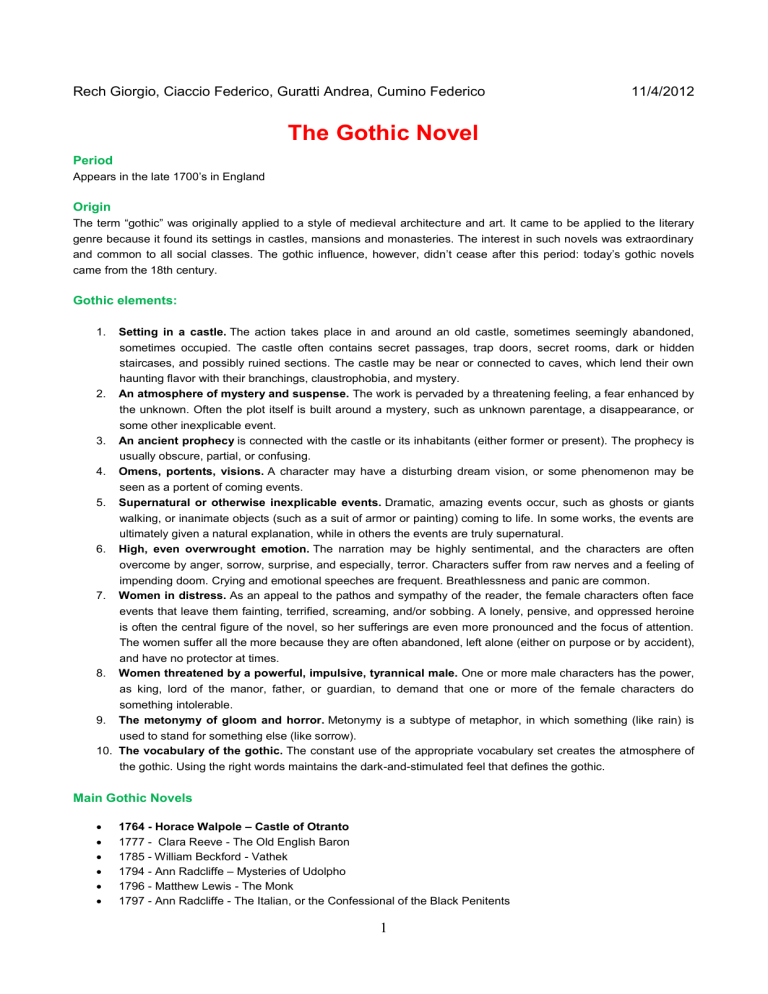
Rech Giorgio, Ciaccio Federico, Guratti Andrea, Cumino Federico 11/4/2012
The Gothic Novel
Period
Appears in the late 1700’s in England
Origin
The term “gothic” was originally applied to a style of medieval architecture and art. It came to be applied to the literary genre because it found its settings in castles, mansions and monasteries. The interest in such novels was extraordinary and common to all social classes. The gothic influence, however, didn’t cease after this period: today’s gothic novels came from the 18th century.
Gothic elements:
1. Setting in a castle.
The action takes place in and around an old castle, sometimes seemingly abandoned, sometimes occupied. The castle often contains secret passages, trap doors, secret rooms, dark or hidden staircases, and possibly ruined sections. The castle may be near or connected to caves, which lend their own haunting flavor with their branchings, claustrophobia, and mystery.
2. An atmosphere of mystery and suspense.
The work is pervaded by a threatening feeling, a fear enhanced by the unknown. Often the plot itself is built around a mystery, such as unknown parentage, a disappearance, or some other inexplicable event.
3. An ancient prophecy is connected with the castle or its inhabitants (either former or present). The prophecy is usually obscure, partial, or confusing.
4. Omens, portents, visions.
A character may have a disturbing dream vision, or some phenomenon may be seen as a portent of coming events.
5. Supernatural or otherwise inexplicable events.
Dramatic, amazing events occur, such as ghosts or giants walking, or inanimate objects (such as a suit of armor or painting) coming to life. In some works, the events are ultimately given a natural explanation, while in others the events are truly supernatural.
6. High, even overwrought emotion.
The narration may be highly sentimental, and the characters are often overcome by anger, sorrow, surprise, and especially, terror. Characters suffer from raw nerves and a feeling of impending doom. Crying and emotional speeches are frequent. Breathlessness and panic are common.
7. Women in distress.
As an appeal to the pathos and sympathy of the reader, the female characters often face events that leave them fainting, terrified, screaming, and/or sobbing. A lonely, pensive, and oppressed heroine is often the central figure of the novel, so her sufferings are even more pronounced and the focus of attention.
The women suffer all the more because they are often abandoned, left alone (either on purpose or by accident), and have no protector at times.
8. Women threatened by a powerful, impulsive, tyrannical male.
One or more male characters has the power, as king, lord of the manor, father, or guardian, to demand that one or more of the female characters do something intolerable.
9. The metonymy of gloom and horror.
Metonymy is a subtype of metaphor, in which something (like rain) is used to stand for something else (like sorrow).
10. The vocabulary of the gothic.
The constant use of the appropriate vocabulary set creates the atmosphere of the gothic. Using the right words maintains the dark-and-stimulated feel that defines the gothic.
Main Gothic Novels
1764 - Horace Walpole
– Castle of Otranto
1777 - Clara Reeve - The Old English Baron
1785 - William Beckford - Vathek
1794 - Ann Radcliffe – Mysteries of Udolpho
1796 - Matthew Lewis - The Monk
1797 - Ann Radcliffe - The Italian, or the Confessional of the Black Penitents
1
1818 - Mary Shelley - Frankenstein
1820 - Charles Robert Maturin - Melmoth the Wanderer
Subsequent evolution
The subsequent evolution of the genre, from the first half of the nineteenth century with Edgar Allan Poe, rather than privileging the fantastic settings (ancient castles, medieval ruins, monasteries) or supernatural (ghosts, demons, monsters), they begin to approach the common man. They dive more into the abyss of 'I, in anguish and in individual and collective fears of modern man and anticipate to some extent the investigation introspective future of psychoanalysis. Some authors such as Robert Louis Stevenson ( The Strange Case of Dr. Jekyll and Mr. Hyde ), who proves to be capable of Poe and his rival with whom he insinuates the idea of splitting (the Good and evil coexist in the same individual), or Arthur Conan Doyle, with the mysteries and dark atmospheres of Sherlock Holmes. It must be said that Stevenson had been sensitive to the strength and ability to dramatize the realism of certain environments with action and the likelihood of the description (also Treasure Island , an adventure novel, based on the historical level of realistic assumptions).
These story lines, particularly in the twentieth century, will take the form of self-narrative genres such as detective story, the noir, the fantasy, the horror.
Even in the twentieth century gothic and supernatural influenced a number of authors, starting with the British. It was then the cinema, from the early twenties which revitalized the general public interest in some of the most famous myths born from the gothic novel in the previous century, like Frankenstein or Vampire stories.
1886 - Robert Louis Stevenson - The Strange Case of Dr. Jekyll and Mr. Hyde
1892 - Arthur Conan Doyle - Sherlock Holmes
1919 - John William Polidori - The Vampyre
Horace Walpole
Walpole was born in London in 1717, the youngest son of British Prime Minister Sir Robert Walpole and his wife
Catherine. Like his father, he was educated at Eton College and King's College, Cambridge.
1738 Walpole left University without taking a degree.
In 1737 Walpole's mother died. According to one biographer his love for his mother "was the most powerful emotion of his entire life...the whole of his psychological history was dominated by it".
In 1739 Walpole went on the Grand Tour with Thomas Gray. He penned the Epistle from Florence to Thomas Ashton,
Esq., Tutor to the Earl of Plymouth.
At the 1741 general election he was elected Whig Member of Parliament for Callington, Cornwall. He held this seat for thirteen years, although he never visited Callington
In 1747 Walpole's lasting architectural creation is Strawberry Hill, the home he built in Twickenham , south west of London, in which he revived the Gothic style many decades before his Victorian successors.
In early 1757 Walpole was elected as King’s Lynn, a seat he would hold until his retirement from the Commons in 1768.
In 1764 he anonymously published his Gothic novel, The Castle of Otranto, claiming on its title page that it was a translation "from the Original Italian of Onuphirio Muralto". The novel opens with the son of Manfred (the Prince of
Otranto) being crushed under a massive helmet that appears as a result of supernatural causes. However, that moment, along with the rest of the unfolding plot, includes a mixture of both ridiculous and sublime supernatural elements. The plot finally reveals how Manfred's family is tainted in a way that served as a model for successive Gothic plots.
2
In Historic Doubts on the Life and Reign of King Richard III (1768), Walpole defended Richard III against the common belief that he murdered the Princes in the Tower.
Horace Walpole died in 1797.
First Published: 1764
Type of Work:
Type of Plot:
Time of Work:
Setting:
Characters:
Genres:
Subjects:
Novel
Gothic
Twelfth century
Italy
Manfred, Matilda, Conrad, Isabella, Father Jerome, Theodore
Long fiction, Fantasy, Gothic fiction
Love or romance, Murder or homicide, Supernatural, Escapes, Mistaken or secret identity,
Inheritance or succession, Castles, Ambition, Heroes or heroism, Italy or Italians, Middle Ages,
Giants, Princes or princesses, Twelfth century
General introduction
The Castle of Otranto, the only novel by Horace Walpole, was first published in 1764. It purported to be a translation of an Old Italian manuscript found “in the library of an ancient Catholic family in the north of England” In the second edition, after the book’s immediate success, Walpole revealed his authorship. The story is set in mediaeval Italy. The exact time is not mentioned in the text of the novel itself, but as Walpole, disguised as a translator, suggests in the preface to the first edition, “it must have been between 1095, the area of the first crusade, and 1243, the date of the last, or not long afterwards” The novel describes a series of events occurring during three days at the castle and lordship of Otranto, including supernatural deeds and leading to fulfillment of an ancient prophecy. The story is told by a third person omniscient narrator.
The Story
The novel begins with a description of the principality of Otranto and the family of Prince Manfred usurper of Otranto. He is a middle-aged prince, a tyrant who seems haunted by a curse from an ancestral old prophecy, that tell
“the castle and lordship of Otranto should pass from the present family, whenever the real owner should be grown too large to inhabit it”.
It is a wedding day and birthday of Conrad, the son and only heir of Manfred of the house of Otranto, and his wife,
Hippolita. Conrad is found crushed to death by a giant helmet. Among the crowd there is a young peasant, Theodore, who identify the similarity of the helmet with the one that is missing from the statue of Alfonso the Good. So Manfred order to his assistants to take Theodore and keep him under the helmet Fearing the end of his dynasty, Manfred decides to divorce Hippolita, and marry Conrad’s betrothed, Isabella. She is dreaded by his design and runs away from him.
Manfred is ready to pursue her, but suddenly a portrait of his grandfather utters a deep sigh and the figure quits the panel and makes a sign to Manfred to follow him. In the meantime, Isabella flees through an underground passage to the
3
neighboring monastery. On her way she meets Theodore, who has managed to escape. He helps her but is recaptured by Manfred. A gigantic foot in armour is seen in the castle by the servants.
The next day, Manfred asks him to persuade Hippolita to agree with divorce so that he can marry Isabella. Jerome pretends to be on his side, and when Manfred asks him if there is a connection between Isabella and the youth, the friar answers in a manner to confirm Manfred’s belief. Impulsive and jealous the tyrant orders Theodore’s immediate execution. When preparing for it, Father Jerome beholds a birthmark on Theodore’s back, which reveals the youth’s identity: he is the friar’s long lost son. Manfred takes advantage of the situation and tells Father Jerome that Theodore will be spared on the condition that Isabella would be handed over to him.
Comes to the castle Frederic, marquis of Vicenza, the nearest known relative to the last rightful owner Alfonso. He demands Isabella to be returned to him and requires Manfred to resign the principality of Otranto. Manfred invites the knight into the castle. The knight enters the castle with the train of his people, including a gigantic sword. Later that evening when Manfred gets to the point of marrying Isabella, “for the good of his people” he is interrupted by Father
Jerome who comes with the news that Isabella has disappeared. While all men find Isabella
, Matilda, Manfred’s daughter, finds Theodore, they fall in love and she helps him escape from the castle. Later, following the advice of
Matilda, Theodore take refuge in the caves of the forest where he meets Isabella, who frightened implore him to protect her from Manfred.
Then appear a knight and Theodore, to defend Isabella, he hurts him .The knight thinking he is about to die reveals to be the father of Isabella who, after hearing that, comes out of hiding. Frederick, wounded, is brought to the castle. Later
Frederic tells his story. He has been prisoner to the infidels and had no information of his daughter. One night he had a dream and through it he found the giant sword that he brought himself up to Otranto. There was a verse engraved on the blade of the sword saying that Frederic’s daughter is endangered at the place where this sword suits to a casque, and that only Alfonso’s blood can save her.
Noticing that Frederic is struck by the charms of Matilda, Manfred offers him the hand of his daughter, and gets consent to marrying Isabella.
Then a servant refer to Manfred that Theodore is in the church at the tomb of Alfonso and he is speaking with a lady, but due to the darkness he could not recognize who that lady was. Manfred, assuming that it is Isabella, rushes to the church and in a fit of jealousy plunges his dagger to the woman’s bosom. As she utters a shriek, Manfred realizes that he has just stabbed his daughter Matilda. She is transported to the castle but soon dies. Theodore proclaims that he is the true
Prince of Otranto. Suddenly, the walls of the castle are thrown down. A giant form of Alfonso appears in the ruins and confirms Theodore’s words. So the prophecy is literally fulfilled.
Manfred, broken by his misfortune and in awe to recent prodigies, gives up Otranto. He confesses that his grandfather
Ricardo, who was Alfonso’s chamberlain, poisoned his master during the crusades in the Holy Land and by a fictitious will declared himself his heir. Jerome explains Theodore’s origin. Theodore’s mother and Jerome’s wife was Victoria,
Alfonso’s daughter which was born after her father’s death. When Theodore was five, he and his mother were taken captive by corsairs to Algiers. Victoria died in a year and Theodore escaped only two years ago and since that time he has been searching for his father, whom he found only now in Jerome.
Manfred and Hippolita decide to retreat to neighbouring convents, to spend the rest of th eir lives in “poverty and prayer”.
Theodore grieves over Matilda’s death but after some time he marries Isabella and they live in Otranto as the prince and the princess.
One or two paragraphs are necessary here, to show, using the list of points in the general introduction, how The Castle of Otranto belongs to the genre of the Gothic Novel, saying what aspects are specifically present in this novel.
4
